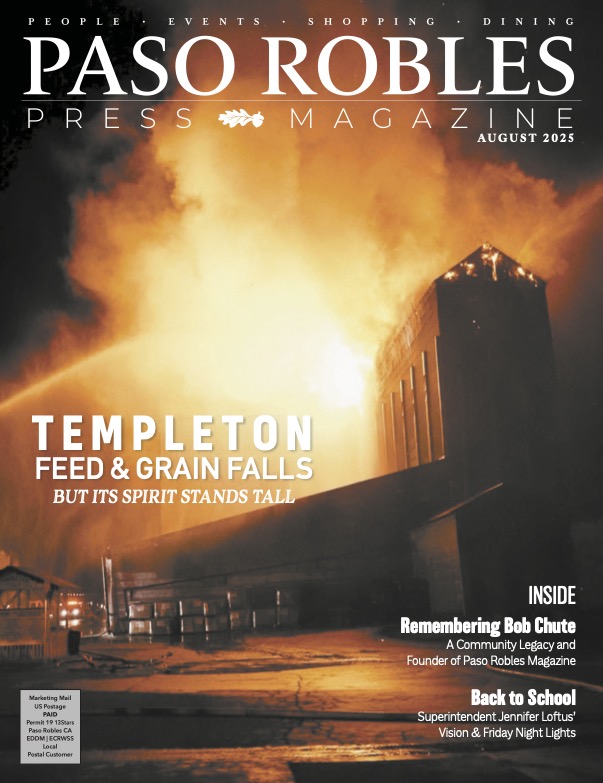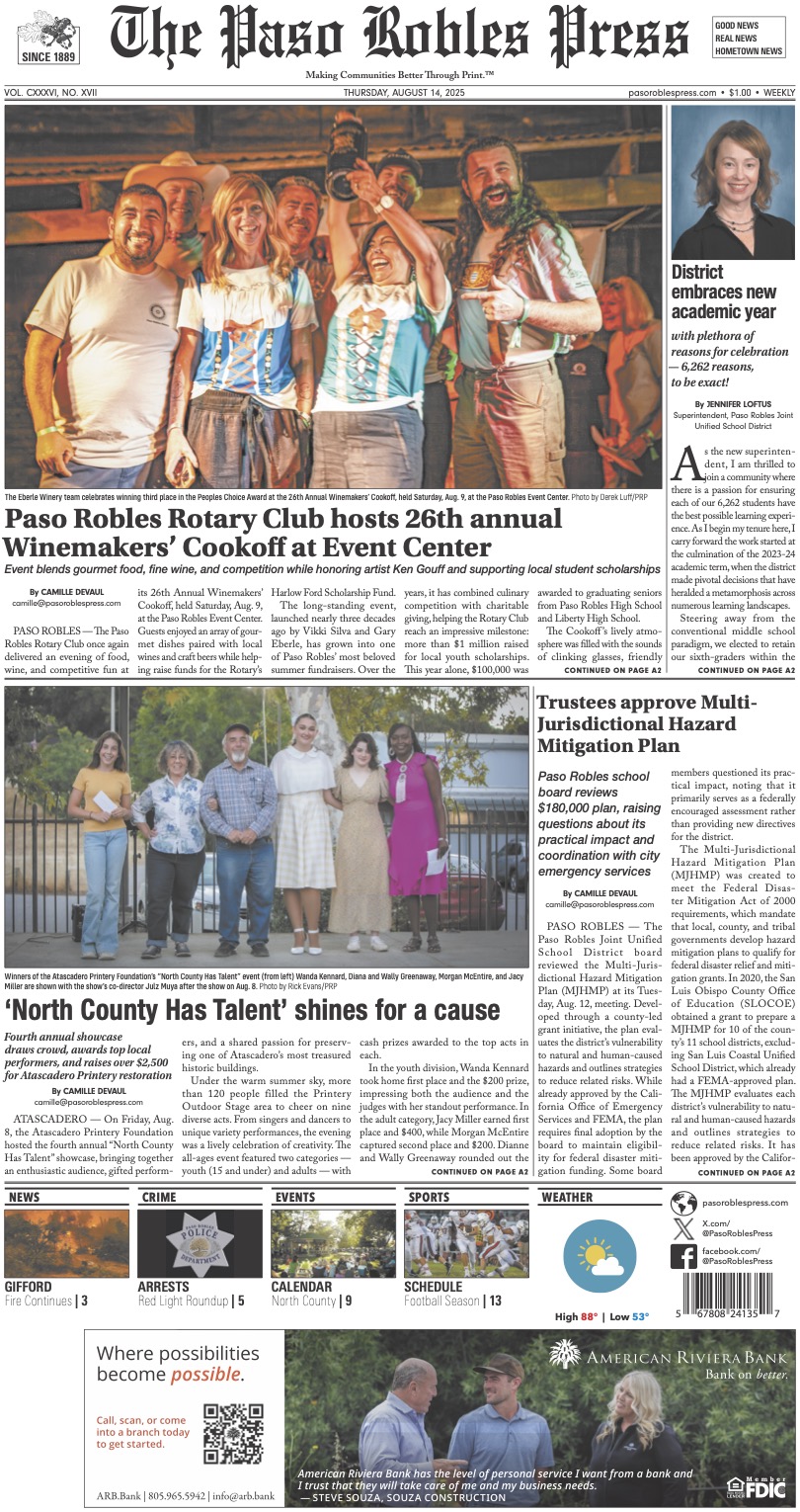Summer’s on and albariño is here for white wine aficionados.
Expressions of this crisp, aromatic grape were presented at the 3rd annual festival exclusively dedicated to this Spanish variety fast gaining momentum in California.
Presented by the Central Coast Albariño Summit, an organization founded in 2016 by Brecon Estate’s Damian Grindley, the festival was staged at the scenic though windy CaliPaso Winery on June 16 with a seminar followed by the walk-around grand tasting.
Festivities kicked off the evening before with a Sunset Albariño Party on Brecon Estate’s tree-shaded terrace where the Grindleys unveiled their 2017 “True Acacia Head” albariño paired with Spanish style nibbles.
Over on the east side, Enrique and Nora Torres, owners of Diablo Paso Wines, entertained 50 guests for their Cena de Albariño & Mariscos at CaliPaso’s Villa Inn. A vertical tasting of Guanabana albariños from vintages 2017 to 2014 was paired perfectly with Kumamoto oysters followed by a three-course seafood dinner.
CaliPaso’s executive chef Chris Krotke’s repast started with a delicious sea bass ceviche, moving on to a choice of grilled monkfish or a shellfish medley and ended with a spread of Spanish cheeses and charcuterie, all washed down with two albariños, the 2016 Gallego Reserve and 2017 La Gloria Dulce, plus a tempranillo and garnacha.
Albariño, a crisp white wine, is native to Spain’s Rias Baixas and Portugal’s Vino Verde regions. This variety has now found a comfortable home on California’s Central Coast, specifically in the Edna Valley AVA where it’s clearly taken a foothold.
Exuding aromas of grapefruit and pineapple, the minerally-driven, zesty wine makes for an ideal summer drink or an aperitif. Here along the Central Coast, albariño’s mouth-watering acidity and brininess combined with citrus flavors is a match made in heaven with coastal bounty.

Nora and Enrique Torres of Diablo Paso Wine
The origin of albariño on the Central Coast can be traced back to veteran winemaker Alan Kinne, now director of winemaking at CaliPaso. Regarded as the Godfather of albariño, Kinne originally planted this variety in Virginia back in 1996, followed by a small test plot in Calistoga.
Over at the Diablo Paso dinner Kinne let it slip that he shipped hundreds of these cuttings from Spain via DHL to the US. “They went through customs but not quarantined,as they are now,” Kinne informed.
Albariño gathered momentum in 1998 when Kinne planted 1.5 acres of this variety in Edna Valley’s Jack Ranch. Cuttings of this planting, known as the Kinne clone, were taken by the Niven Family for its historic Paragon vineyards, now regarded as the leading grower of albariño in California with some 50 acres planted.
Kinne informed that although just 350 acres of albariño are planted in California, this acreage outnumbers other white varieties such as marsanne, roussanne, grenache blanc and pinot blanc.

Chad and Lauren Rava
We learnt more about this variety at the Saturday afternoon sit-down seminar featured a tasting of five albariños. Moderated by Stewart McLennan (Golden Triangle Wine), the five-member panel explored the origins and versatility of albariño. The wines ranged from grapes sourced in Edna Valley and Santa Ynez to Paso Robles. Panelists Grindley and Kinne were joined by fellow Paso winemakers Neil Roberts (Clavo Cellars) and Dave McGee (Monochrome Wines) as well as Rick Longoria (Longoria Wines) from Santa Ynez.
The key to retaining the classic character of albariño, Grindley offered, is to do stainless steel fermentation and age in mostly neutral barrels for three to four months. This is an early drinking wine.
Grindley prefers acacia wood instead of oak. “Acacia gives structure and more of a stone fruit character,” he commented. Oak, he added, gives a vanilla and toasty flavor, a disadvantage for albariño: “You mask the aromatics of the wine with oak.”
Grindley got interested in albariño as an alternate white wine for his wine club portfolio. “We were looking for a summer white as Rhône whites are more winter whites,” he commented. By chance Grindley came upon some albariño from Price Canyon and was impressed by its freshness. His first bottling of albariño went on to garner high ratings from wine critics.

Lisa and Jason Bushong
The grand tasting afterwards of 40-pus wines poured by 23 wineries, the majority from Paso, offered a range of albariños, from austerely crisp to a lush mouthfeel. But the unmistakable flavor present in all was the wine’s distinctive citrusy notes and bracing acidity.
Mostly 2017 vintages were poured with a few 2016s. There were the cool climate albariños sourced from Edna Valley such as Lazarre’s high-tone aromatic, acid-driven style; Metrick’s albariño with a woosh of citrus; Tangent’s oozing crisp minerality; and Bodega Paso Robles’ wine expressing freshness and aromatics.
Then there were winemakers crafting wines from Paso’s warm east side vineyards. I noticed a certain Paso style emerging showing a rounder mouthfeel. “It’s richer, leaning toward viognier,” commented Jason Bushong who sources from Barr Estate’s east side vineyard.
“We are going to see warm climate albariño,” contended winemaker Curtis Hascall, of Shale Oak’s aromatic, fuller style. The 300 annual-case production is crafted from the winery’s four-acre vineyard in the Estrella district.

Oysters and albariño, a match made in heaven at Diablo Paso’s seafood dinner staged at CaliPaso Winery
Others growing albariño on the east side include Pear Valley Estate Wine, Barr Estate and RAVA Wines, which has made a serious investment in the variety. “We have planted 16 acres of albariño,” noted Lauren Rava.
This being Paso where winemakers love to blend, Derby Wine Estate added a splash of grenache blanc to its honeysuckle-tinged albariño aged in amphora and neutral French oak.
Other participating wineries included Opolo, Tooth & Nail, Kaleidos, Kaena, Broken Earth, Vina Robles, CaliPaso, Bodega de Edgar and Diablo Paso.
The festival’s CaliPaso venue has come full circle. Kinne, now the winemaker at CaliPaso, was also the winemaker at Martin & Weyrich (former owner of the CaliPaso estate). And it was Martin & Weyrich who first planted albariño at its Jack Ranch estate in Edna Valley where the varietal took root on the Central Coast.
The Central Coast Albariño Summit has tapped into a huge interest in this variety from the winemakers and consumers alike. Proceeds from the festival benefit local charities.












